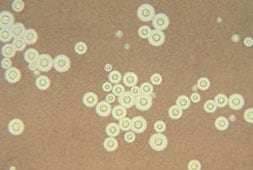11 February 2014. Medical researchers at University of Rochester in New York found two drugs treating breast cancer have properties that point to their potential as a treatment for Cryptococcus, a fungus causing meningitis in people with HIV/AIDS. The team led by Rochester’s Damian Krysan, with colleagues from Temple and Duke universities and University of California in San Francisco, published its findings today in the journal mBio.
According to the U.S. Centers for Disease Control and Prevention, cryptococcal meningitis cases occur among people with HIV/AIDS, at a rate of about 1 million cases per year worldwide, causing some 625,000 deaths. The disease is caused by the Cryptococcus fungus that spreads from the lungs to the brain.
HIV patients with compromised immune systems are among the most susceptible to cryptococcal meningitis. While the use of anti-fungal drugs helped reduce the number of cases in developed countries, cryptococcal meningitis continues to be a major problem where resources and access to health care are limited.
Krysan and colleagues screened a library of off-patent drugs for potential agents for molecules with the power to kill Cryptococcus organisms, and identified tamoxifen, a breast cancer drug marketed as Nolvadex by AstraZeneca and Soltamox by Dara BioSciences. Tamoxifen was already known from earlier studies to have anti-fungal properties.
The researchers further noted tamoxifen and a similar breast cancer drug, toremifene, are taken as oral drugs, and cross the blood-brain barrier, which add to their value as potential treatments for cryptococcal meningitis. Toremifene is marketed as Fareston by ProStrakan.
The Rochester team tested tamoxifen and toremifene in combination with standard anti-fungal drugs in the lab — both in cultures and with mice — and found the combinations boost the power of the anti-fungal drugs. Tamoxifen and toremifene, the researchers discovered, help inhibit the growth of the cryptococcal fungus within immune system cells, a property that the anti-fungal drugs do not have on their own. In addition, the cancer drugs were found to bind to and inhibit the calmodulin protein that facilitates the growth of the fungus.
The results suggest, say the authors, that tamoxifen and toremifene can serve as frameworks for the development of anti-cryptococcal drugs. Being able to repurpose existing drugs can short-cut the drug development process, at considerable time and cost savings, even if further development is needed to take the therapies to market.
Read more:
- Pharmas, Academics Partner on New Treatments from Old Drugs
- Five More Pharma Companies Join NIH Drug Extension Project
- Three Drug Makers Partner with NIH to Expand Therapies
- NIH Funding Portfolio Evaluated With Investment Metrics
- NIH, Eli Lilly to Partner on Drug Effects Profiles
* * *


 RSS - Posts
RSS - Posts